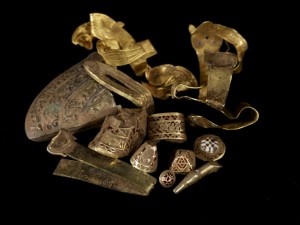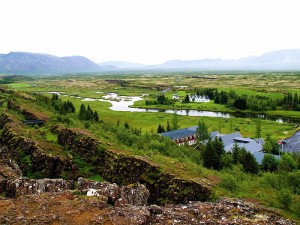 In the late spring of A.D. 793, British peasants experienced their first taste of Viking warfare, a clash so terrifying that it seemed to be of supernatural origin. “Terrible portents appeared over Northumbria and miserably frightened the inhabitants: these were exceptional flashes of lightning, fiery dragons were seen flying in the sky,” noted one scribe. “A little after that, in the same year on 8 June, the harrying of the heathen miserably destroyed God’s church in Lindisfarne by rapine and slaughter.”
In the late spring of A.D. 793, British peasants experienced their first taste of Viking warfare, a clash so terrifying that it seemed to be of supernatural origin. “Terrible portents appeared over Northumbria and miserably frightened the inhabitants: these were exceptional flashes of lightning, fiery dragons were seen flying in the sky,” noted one scribe. “A little after that, in the same year on 8 June, the harrying of the heathen miserably destroyed God’s church in Lindisfarne by rapine and slaughter.”
The Vikings, it seems, didn’t play by British rules of engagement.Though they were farmers like the Anglo-Saxons, the Vikings had yet to convert to Christianity: they preferred their own gods. So as Viking chiefs set out with their nobles and thralls on raids to new lands, they treated churches as places of plunder and local priests as lambs for the slaughter.
 The Anglo-Saxon peasantry, however, had never seen an enemy massacre monks or ransack priories and monasteries for treasure. And so deep an impression did this make on the local citizenry that the Vikings quickly became enshrined in British history and literature as fearsome madmen. And the Scandinavians did little to dispel this initially: they raided British coastlines over and over again, eventually colonizing great chunks of northern and eastern England in the 9th century.
The Anglo-Saxon peasantry, however, had never seen an enemy massacre monks or ransack priories and monasteries for treasure. And so deep an impression did this make on the local citizenry that the Vikings quickly became enshrined in British history and literature as fearsome madmen. And the Scandinavians did little to dispel this initially: they raided British coastlines over and over again, eventually colonizing great chunks of northern and eastern England in the 9th century.
But the Vikings weren’t just fighting men. They also understood the value of settling disputes without butchering everyone in sight. And I was reminded of this lesser known side of the Vikings recently by a new discovery in Sherwood Forest.
We all tend to think of Sherwood Forest as the refuge of Robin Hood and Maid Marian (something that historians incidentally have never been able to verify.) What researchers do know, however, is that Sherwood Forest was once Viking territory. Indeed, this green space lay at the heart of Danelaw, a sprawling territory constituting Viking-occupied England from the 9th to the mid-10th century.
And that brings me to the recent discovery. In late December, three British amateur historians announced they had found what appears to be an ancient Viking assembly ground known as a “Thing” in Sherwood Forest. The find prompted an archaeological investigation, which led to a prestigious listing on Britain’s National Monuments Record.
The discoverers found the moundlike site by some very determined sleuthing, first locating it on the ground by following directions on a 200-year-old documents, then tracking down the site’s name on books and maps going back to the 13th century. It was originally known as Thynghowe.
 The best-known surviving Viking thing today stands in Iceland, at a place called Thingvellir (see left). This outdoor assembly ground just happens to be one of the most spectacular spots on earth, ringed by mountains, braided by ice-cold mountain streams and cradled in a broad rift valley. At Thingvellir, Viking chieftains founded Iceland’s first parliament in 930, and Icelandic friends tell me that it is the oldest parliament in the world. They may well be right.
The best-known surviving Viking thing today stands in Iceland, at a place called Thingvellir (see left). This outdoor assembly ground just happens to be one of the most spectacular spots on earth, ringed by mountains, braided by ice-cold mountain streams and cradled in a broad rift valley. At Thingvellir, Viking chieftains founded Iceland’s first parliament in 930, and Icelandic friends tell me that it is the oldest parliament in the world. They may well be right.
According to the Norse sagas, Iceland’s chieftains chose the location of Thingvellir very carefully: its woods could provide kindling for many fires; its meadows could feed many horses; and it was relatively easy to reach from all the main villages. Moreover, it possessed nearly perfect acoustics, ensuring that all who attended the assembly could hear what was said.
Sherwood Forest’s Thynghowe seems to possess many of the same attributes–particularly its acoustical qualities. According to Stuart Reddish, one of the site’s discoverers, a speaker standing on Thynghowe could be heard hundreds of yards away.
Looks to me as if the early portents might have been wrong. The Vikings weren’t all bad news for Britain. Indeed, they may have helped plant the first seeds of democracy there.
Photos: Top, Lightning at Sunset, December 31, 2005, courtesy Scotto Bear. Middle: Anglo-Saxon treasure known as the Staffordshire Hoard, courtesy David Rowan, Birmingham Museum and Art Gallery. Bottom, Thingvellir National Park, Iceland, courtesy of Ville Miettinen.
English and British are words that don’t overlap for this period, because the ‘British’ were the Celtic or Romanised peoples the Anglo-Saxon culture displaced or replaced. So we need to be careful with our use of the terms; British and English are opposed at this point. The Vikings did indeed raid British coasts, and also English and Scottish ones, and they settled a good chunk of Scotland and founded several Irish town, including Dublin, also.
793 probably wasn’t the first attack (on England), that’s usually reckoned to have been a raid at Portland some time between 786 and 802 which the Anglo-Saxon Chronicle says was the first attack.
Anglo-Saxons had frequently seen their fellow Anglo-Saxons attack monasteries. For example, Bede reports a famous massacre of monks at Chester in 602. Those monks were British and the relevant Angles still pagan at that point, but this continued long after the conversion and in Ireland even more so; there monasteries’ armies would fight each other. While the Vikings certainly privileged Church targets, it wasn’t a religious motive, it was because they were rich; the raiders would sack anywhere with treasure. They raided pagans in the Baltic and Muslims in Spain equally happily.
The Anglo-Saxons had been having assemblies at sites like Thyngehowe for a long time before this, usually at hundred meetings; it’s possible this was such a place already, renamed. It can’t have “originally” been called Thyngehowe, as you state, because that’s an Old Norse name; presumably there was an English name for it before that which this one replaced (and a Celtic one before that, and who knows what before that…)
Of course it’s unlikely that those hundred assemblies were ‘democratic’, but then we don’t know that of Thyngehowe either. The Danes in England and Norse in Scotland and Ireland had kings and earls to lead them, according to the sources. Iceland probably isn’t representative of every Viking settlement everywhere, not least because it was always really poor, meaning that social stratification was fairly compact. We can expect Viking settlers in England to have retained a military organisation at least for a while so making this a birthplace of democracy in England is probably too hopeful, sorry.
Other than that, nice piece! If you have more early medieval stuff lurking I’d be happy to recommend some quick reading.
Jonathan: I’ll respond to your comments either later today or tomorrow. At the moment, I’m swamped.
Jonathan:
Let me respond to your comments.
1. I take your point about English and British not overlapping during the 8th century. But I am writing for a general readership, rather than a group of British medievalists, and I used the word British simply to convey a sense of geography, not specific tribal groups.
2. The 793 attack, which I describe, is the first raid of which we have clear knowledge. The attack at Portland, as you point out, has a considerable date range, placing it as late as A.D. 802, nine years after the Lindisfarne attack.
3. These earlier attacks against monasteries seem to have been forgotten by the time of the Lindisfarne assault. In a letter to King of Northumbria, the English scholar Alcuin of York writes: “”Lo, it is nearly 350 years that we and our fathers have inhabited this most lovely land, and never before has such terror appeared in Britain as we have now suffered from a pagan race, nor was it thought that such an inroad from the sea could be made. Behold, the church of St. Cuthbert spattered with the blood of the priests of God, despoiled of all its ornaments; a place more venerable than all in Britain is given as a prey to pagan peoples.”
4. I myself make the point that the Vikings targeted the church at Lindisfarne as “a place of plunder.”
5. Well there may have been many names for Thynghowe, but the only old name we have certain knowledge of is “Thynghowe.”
6. I think you are reading far too much into the last line of my post. I am not saying that the Vikings brought democracy as we know it to England. I am only speculating on the possibility that they brought the seeds, i.e. Viking style assembly. And Iceland’s assembly is a particularly well-known example of a Viking Thyng.
The British/English choice is tricky, I do realise; I just wanted to stress how a sentence like “The Vikings, it seems, didn’t play by British rules of engagement” reads to someone who knows the period.
The thing about the Portland attack is that the Anglo-Saxon Chronicle says it was the first, that’s all: “These were the first
ships of the Danish men that sought the land of the English nation.” The Chronicle reports Lindisfarne in due order s. a. 793, so it’s not as if they didn’t know. We just don’t know exactly when this attack was. Why do you suppose the Chronicle might be wrong?
The Alcuin quote is germane of course, but what was horrifying him there is that the attack was being brought by pagans, not that the monastery was the target, wouldn’t you agree? Obviously an England with monasteries in to be attacked was not pagan; the internal attacks I speak of, especially in Ireland, were mounted by Christians.
Is Thynghowe the oldest name we have for the place, in fact? I haven’t looked it up in the Dictionary of English Place-Names, and I presume you haven’t either. Anyway, the point is that it’s an Old Norse name. It can’t, therefore, pre-date the Vikings, but the hill obviously does. To presume that the Danish settlers were the first people to name it or use it just seems very odd to me, especially given the number of other such sites which have been shown to be Anglo-Saxon assembly places.
Lastly, Iceland’s parliament is indeed a fine example of a Thing. (The ‘y’ is an English affectation.) And Thynghowe may indeed be the earliest known instance of the name in England! It’s just that we haven’t got much reason to suppose these were democratic assemblies in non-Icelandic cases, except, of course, the same reports by Tacitus of chiefless German tribes that have been used to make the Anglo-Saxons, in their earlier turn, the progenitors of democracy in the British Isles since the nineteenth century. As I say, the Vikings in England had kings and earls, paid taxes and did military service, much like the Anglo-Saxons. If you want to suppose they somehow had more democracy to bring than those among whom they settled, you have to explain how they might have *got rid* of that monarchical apparatus once settled so as to ‘return to equality’. It seems very complicated to think out to me, when one actually does think about it.
Jonathan:
1.) Sorry, I think you are still dead wrong about the Portland incident being the first taste of Viking warfare in England. In addition to the dating range problem, there is a second difficulty.The Anglo-Saxon Chronicle reports that only one person was killed in the Portland incident.I’d hardly call that a major attack,much less warfare.But the Lindisfarne massacre–described above in my opening paragraphs and by Alcuin of York–is clearly an act of war.
2.) Sorry I don’t agree with your interpretation of the Alcuin quote at all. If you read his description carefully, you’ll see that he places a lot of emphasis on the despoiling of a sacred place. “Behold, the church of St. Cuthbert spattered with the blood of the priests of God, despoiled of all its ornaments; a place more venerable than all in Britain is given as a prey to pagan peoples.”
3.) I certainly never said or indicated that the Vikings in England or elsewhere lacked an elite, which usually took the form of powerful local chieftains.But the presence of such powerful chieftains in Iceland did nothing to stymie the rise of the thing in Iceland, an assembly created to resolve disputes. I am sorry that you don’t like my speculation that the Vikings may have planted the early seeds of democracy in England–these open-air assemblies–just as they did in Iceland. But I stick by it.
Just a quick comment re Thynghowe. If you look it up in the EPNS’s Place-Names of Nottinghamshire (it’s probably too small to appear in a Dictionary of English place-names) you will see that the earliest recorded form from around 1300 is indeed ‘Thynghowe’. Today the place is called Hanger Hill. There are a number of places in the British Isles, including a few in England, with the ‘thing’ element. And yes, the Anglo-Saxons had meeting-places too. In fact there is a whole project on this called Landscapes of Governance, based at UCL and Nottingham, and another international ‘thing’ project based at Oslo, Vienna and UHI. So it’s a hot topic at the moment.